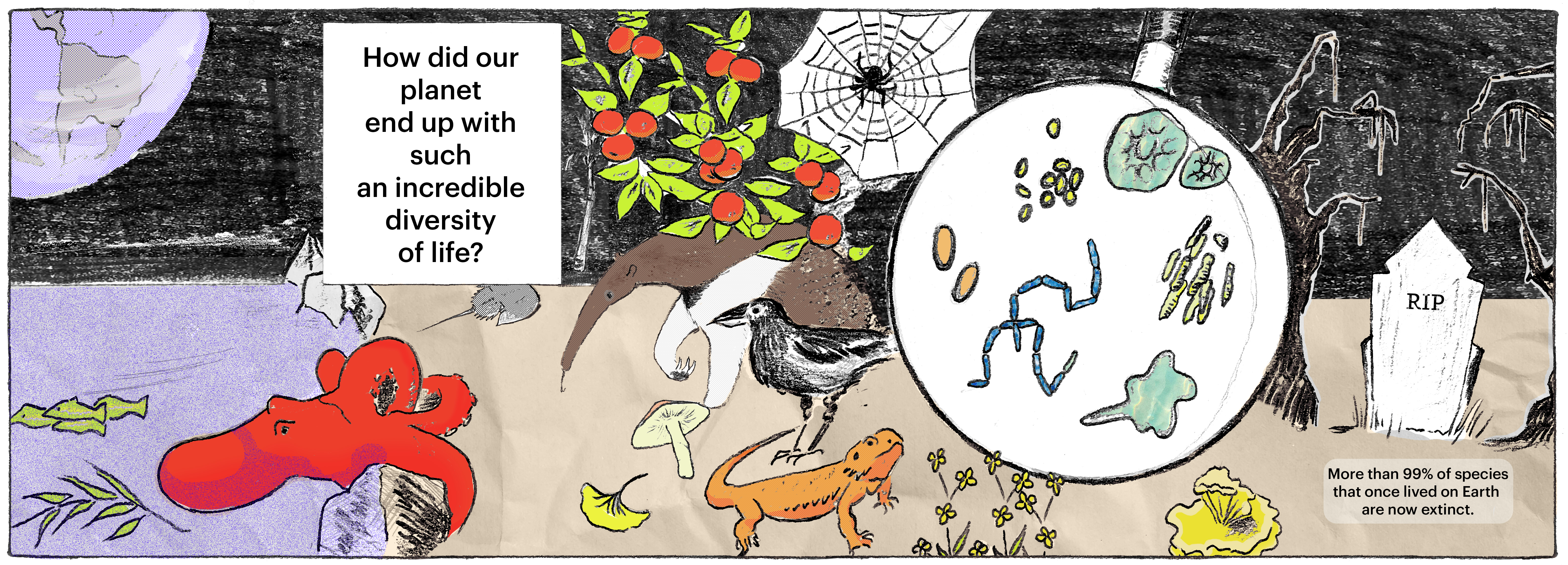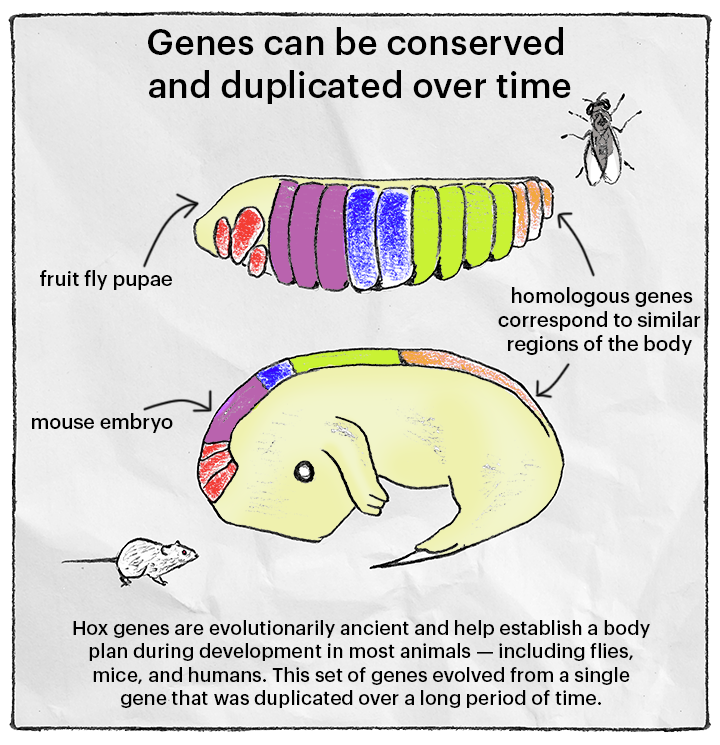From primordial pools to the petri dish — a cartoon explainer on evolution
An understanding of evolution informs many of the questions in foundational biology that Whitehead Institute scientists are researching. This cartoon explains some of the fundamental concepts in evolution. This article is part of our series, “Evolution in action”. To view the entire collection, click here.

Evolution has driven the amazing diversity of life on this planet
How many species exist on Earth today? The short answer is: we don't know. Estimates range from 2 million species, to an unfathomable 3 trillion. This only includes species alive today — by examining the fossil record, scientists estimate that more than 99% of species that ever lived are now extinct.
Maybe even more mind-boggling than these numbers is the astounding variety across species. Look out the window, and obvious examples of biodiversity abound: a tree is a living organism, and so is the squirrel nesting on one of its branches. You may notice a mushroom cap, some ants crawling up the trunk. This hypothetical scene doesn't even contain the rich cast of characters invisible to the naked eye: unicellular organisms including bacteria, protists and yeast; and larger-but-still-invisible multicellular organisms, like nematodes dwelling in the soil.
How did our planet end up with such an amazing diversity of life? The answer is evolution, the process by which organisms change and diversify over the course of Earth's history.
DNA, RNA and protein: all life contains the same building blocks
To understand how evolution happens, we go back to the basics. Every organism, from a single-celled prokaryote to a human, is made of the same molecular building blocks. DNA, short for deoxyribonucleic acid, contains the instructions for an organism's development and function. These instructions are read into RNA, short for ribonucleic acid, which in turn are translated into proteins, highly complex molecules that make up our cells and keep them functioning.
A particular stretch of DNA that contains instructions for building a specific protein is called a gene. Genes are passed down from one organism to its offspring, and subsequently future generations. (The complete collection of DNA within a cell is called a genome. In multicellular organisms, nearly every cell contains its own copy of the genome.)

The transfer of genetic information is done one of two ways, either through asexual or sexual reproduction. In sexual reproduction, two parents combine their genetic material to create a new individual. In the majority of organisms that reproduce sexually — including most plants, animals and fungi — their genomes in most cells contain two copies of every gene. But inside sex cells, such as eggs and sperm, the genome is pared down to only one copy of each gene. When two sex cells unite, their combined genetic material creates a new genome, once again with two copies of each gene. (This cycle ensures that a genome does not balloon across generations.)
To learn more about RNA, which translates our genetic code into proteins, see our RNA cartoon explainer.
How species change over time: genetic variation, natural selection and genetic drift
As generations pass, genes can acquire mutations over time, contributing to genetic variations within a population. A given mutation can be neutral, harmful (at its most extreme, being incompatible with life), or even beneficial to an organism. Mutations that are passed down contribute to genetic diversity on a population level. Different versions of the same gene help explain some of the diversity within a population: one cat might be orange, another has a tabby coat, thanks to their genes. (Very few traits are determined by a single gene; the color of a person's eyes, for example, is influenced by variations found in over a dozen genes.)
Diversity in a population is what enables change over time — evolution. Consider a population of imaginary organisms, the shape creatures. In ancient history, most shape creatures are circular. A few happen to have a genetic composition that makes them more triangular. Eventually, they encounter an unexpected obstacle in their environment, favoring shape creatures that are triangular. Circular shape creatures begin to die out, and triangles become the dominant form.
In real life, natural selection can take many forms. Certain genetic variations, also called genotypes, may allow an organism to better cope with cold weather. Especially elaborate plumes on a male peacock may make him a more attractive mate, more likely to pass his fancy-feather genes to the next generation. Or, if green beetles look tastier to birds, over time, you might expect fewer green beetles. Evolution over millions of years has led to amazing adaptations that can be seen all around us, even in ourselves: we have the brains to design a can opener, and the thumbs to use it.
In other instances, the composition of a population's gene pool can shift, not because of selective environmental pressures, but because of chance — a phenomenon called genetic drift. Say a natural disaster wiped out most of the shape creatures: only a handful survive, including one shape creature with a pink mustache. Suddenly, the genes that make a shape creature grow a pink mustache make up a much larger fraction of the gene pool than before, even if a pink mustache isn't that useful for survival or reproduction.
When an event indiscriminately wipes out a huge fraction of a population, it's called a genetic bottleneck. A real-life example of a genetic bottleneck can be found in elephant seals, which were hunted to near extinction in the 1800's. Their numbers have since recovered, but genetic diversity in elephant seals remains low.

Insertions, deletions, and duplications, oh my!
Mutations are not the only way that genetic diversity is introduced into a population. When organisms reproduce sexually, their genetic material is shuffled, a process called recombination. When cells divide, DNA becomes tightly coiled, creating 3D structures called chromosomes. During meiosis, or a specific form of cell division that creates germ cells which go on to become egg and sperm, chromosomes from the organism's two parents align with each other, then swap genetic sequences, creating chromosomes with a new combination of gene variations, which can interact with each other in new ways.
Most mutations fall into one of two categories: those that affect a single gene, and those that change the structure of an entire chromosome.
Imagining DNA as a ladder, each "rung" is linked by two complementary subunits, called base pairs: thymine (T) pairs with adenine (A); cytosine (C) with guanine (G). Multiple base pairs create specific sequences — a genetic code, containing the instructions for life. Sometimes one base pair is replaced with a different base pair. These substitutions may have a minor effect, or no effect at all. Potentially more consequential are insertion and deletion point mutations, which either add or delete a single base pair. Insertions and deletions are sometimes called frameshift mutations, since adding or removing a base pair can shift the entire "reading frame" a gene, potentially altering the function of associated proteins.
Chromosomal mutations create changes on a larger scale. Pieces of the chromosome may disappear over time. For example, the Y chromosome in human males evolved from a non-sex chromosome that had many more genes. In other cases, sections of the chromosome are duplicated. Chromosomal duplications are usually harmful, but every once in a while duplicated genes can go on to fulfill new, beneficial roles. One example is Hox genes, a group of regulatory genes that help establish the head-tail axis of many animals, from humans to fruit flies. Parts of one chromosome can also move to a new chromosome, or become inverted.

Surprises in the tree of life
The study of genetics greatly informs scientists' understanding of evolution, but that wasn't always the case. Long before the discovery of DNA, scientists classified organisms based on their physical traits. If two species had similar traits, they were thought to be closely related. But this assumption can be misleading. For example, damselfish, brightly-colored fish that occupy coral reefs, can look virtually identical to each other. Two fish may sport the same shape of fins and banana-yellow shade of scales, but belong to completely separate species that evolved strikingly similar traits. Natural selection worked on each species independently, driving towards similar adaptations — an example of what is called convergent evolution. (In the case of damselfish, UV lighting reveals scale patterns unique to each particular species, a way for fish to distinguish individuals belonging to their group.)
In other cases, selective pressures work in the opposite direction. All birds have beaks, but those beaks have been honed by millions of years of evolution to be well-suited for specific tasks. Duck bills are perfect for scooping up fish and underwater vegetation; a sparrow’s short, pointed beak is great for cracking into seeds. This awesome variety is one of many examples of divergent evolution.
Phylogenetics, or the study of how organisms are related, is in general not always intuitive. Acoels, also known as panther worms, are a water-dwelling flatworm only a couple millimeters in length. Planarians are also tiny water-dwelling worms. One coule assume that they’re closely related, but they are not. Their last common ancestor lived 550 million years ago, when acoels split away from other bilaterians (animals symmetrical on two sides, including humans). Planarians and humans therefore share a more recent common ancestor — meaning planarians are more closely related to humans than they are to acoels.

Evolution in the lab
Evolutionary biologists are not only piecing together a story about ancient history. In some cases, they can observe evolution happening in real time. Organisms with short lifespans, like fruit flies, can exhibit evolutionary changes in a matter of months or weeks. Cancer cells, although not an independent organism, are another example of evolution observable in the lab. Researchers are interested in tracing the lineage of cancer cells, much like tracing relatives on a family tree, to see where mutations arise and which mutations give cancer the ability to metastasize. Insights into how cancer cells change over time may lead to new therapies for patients.
Whitehead Institute researchers study the fundamentals of biology, parsing the function of genes and other cellular components in both health and disease. This work is informed by an understanding of evolution — how these biological systems came to be. Continue reading about evolution research at Whitehead Institute in our collection of stories, "Evolution in Action."

By Madeleine Turner
Special thanks to Kutay Deniz Atabay